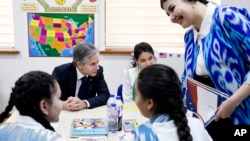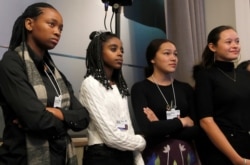Student Union
The Anxiety Lurking Behind COVID-19 for Many Under 30

Pushed to the back of Gen Z anxieties by the COVID-19 pandemic, climate change remains a looming stressor for many people younger than 30, experts say.
“Natural disasters precipitated by climate change, including hurricanes, heatwaves, wildfires, and floods can lead to ... increased rates of depression, anxiety, post-traumatic stress, and other mental health disorders,” according to researchers at the University of British Columbia and Simon Fraser University in Canada, and Johns Hopkins University in Baltimore.
The authors label the fear “eco-anxiety, climate distress, climate change anxiety, or climate anxiety,” writing in the British medical and science journal, The Lancet Planetary Health.
In other words, the future is not looking bright from the perspective of many people under 30.
Xiye Bastida, a student at the University of Pennsylvania, has been fighting the climate crisis since her hometown in Mexico flooded when she was 13. She calls it a pivotal moment in her environmental activism.
“Sometimes we don't realize when we actually start caring about something and acting upon it,” she said.
Mexican-Chilean Bastida is one of the founding members of the New York City chapter of Fridays for Future, a strike movement that pressures public officials about climate change by protesting outside schools and government offices. She is also the co-founder of Re-Earth Initiative, which seeks to educate the public about climate issues.
Bastida’s generation might be more likely than adults to experience climate anxiety, the Lancet Planetary Health paper states.
“They are at a crucial point in their physical and psychological development,” the authors wrote, “when … stress and everyday anxiety elevate their risk of developing depression, anxiety, and substance use disorders.”
Bastida said she has experienced eco-anxiety and burnout from climate activism. She ended up in the hospital with heart palpitations because she was so stressed, she told VOA.
“For me, the way I experienced and dealt with climate anxiety was just by always blaming myself for not doing enough,” Bastida explained.
She continued, “If you don't take care of yourself, if you don't take care of your home, if you don't take care of your well-being, you cannot take care of the world.”
“Climate change is rapidly creating a less safe, less secure [food security, national security], less healthy, and less prosperous world,” Edward Maibach, director of George Mason University’s Center for Climate Change Communication (4C), wrote to VOA.
“Today’s young people will be living in this world, as conditions deteriorate, unless the nations of the world rise to the challenge they currently face.
“In my view, young people who don’t care about climate change are not paying attention,” he wrote.
But many young people are paying attention and trying to effect change. The children and grandchildren of those who planted trees for the creation of Earth Day and the Environmental Protection Agency in 1970, are giving environmental justice a hard push forward.
The movement has been propelled by young people everywhere.
Sweden’s Greta Thunberg riveted global attention as she sat outside a Swedish Parliament meeting, her expression capturing the impatient disgust of her generation with inactivity over climate change.
Other famous young environmentalists include Canadian Autumn Peltier from the First Nations community, Argentinian Bruno Rodriguez, and Helena Gualinga from the Ecuadorian Amazon.
Nikayla Jefferson is a volunteer writer for the Sunrise Movement, co-founder of the San Diego hub, and a doctoral candidate at University of California-Santa Barbara. For her, the scariest part of climate change is basic, she says.
“The total loss of human life and the land that gives us our history and story,” she said. “We understand climate change science and how devastating it is to the Earth, but addressing carbon emissions is not enough,” Jefferson wrote to VOA. “We need to look at climate change through a human lens because climate change is the not the only existential threat people are facing.”
Anxiety about climate change and a desire to act erases political lines, according to research from Pew, Brookings Institution and 4C. In the 2020 presidential election, climate change was among the top three issues to young voters.
And 4C’s Maibach says that youth leadership about climate change has woven generations together on the issue.
“Politicians and CEOs alike have every reason to want to keep young people happy, because they won’t keep their jobs for long if they don’t,” Maibach wrote. As the percentage of younger votes eclipses those of Baby Boomers, born between 1946 and 1964, the Gen Z and millennial vote becomes more powerful.
“CEOs are not directly accountable to the public, but corporations are becoming increasingly sensitive to public opinion, especially that of young people, because they want to attract the best and brightest young people as employees, and they want to earn the loyalty of young customers,” Maibach wrote.
While Bastida said she still worries about the future, she looks on the bright side and believes her generation can have an impact.
“I think that we have to realize that that timeline is already running out,” she said. “And we cannot just keep talking about what we're going to do, we need to actually start doing it. And when I see people actually doing things, when I see initiatives coming up, when I see companies changing their whole business model, that's what makes me optimistic.”
See all News Updates of the Day
- By VOA News
Michigan State international students get their own space

Michigan State University in East Lansing, Michigan, is setting aside a space in the International Center for international students.
Nidal Dajani, vice president of the school's International Student Association, said that the club plans to use the space to host events and hopes to collaborate with other student groups.
- By Dylan Ebs
International students find community during Pride Month

For LGBTQ+ international students, Pride Month, observed in June, is a unique time to reflect.
They hold on to multiple identities — both their LGBTQ+ identity and their cultural background — but coming to terms with them is not always easy.
For graduate student David Zhou, these identities can feel conflicting as transgender rights in China remain a controversial issue and spaces for LGBTQ people close. Zhou, 25, is transgender and pursuing an education in the STEM field at an urban university in the Midwestern United States.
VOA is using a pseudonym for Zhou’s first name and is not naming his university to protect his identity due to safety concerns back home in China. Zhou is not open about his transgender identity to his family.
During Pride Month, Zhou said he attended multiple LGBTQ+ events in his community and is surrounded by a supportive group of LGBTQ+ students who can relate to his experiences. But he’s not open about his identity to everyone on campus and said he doesn’t disclose his preferred pronouns to everyone to avoid transphobic comments.
“I feel like I have to make some judgments of the character of that person to see if they’re a good person to disclose [my identity] to,” Zhou said.
Zhou’s Pride Month celebrations included attending local markets with LGBTQ+ vendors and hanging out with his LGBTQ+ friends.
“They normalized being trans and for a long time I feel like trans identity is, should I say a vulnerability, brings me fear and worrying about discrimination, but having those events are helpful because it allowed me to see that queer people could just [live] openly,” he said.
At social events where few international students are present, Zhou said it can be tough to fit in.
“There's a lot of times like when they were talking about things I kind of, don't really understand, mostly because I kind of lack some background experience or knowledge,” he said.
Zhou said he is not aware of specific groups for LGBTQ+ international students at his university, but said international students are more prevalent in graduate programs and therefore find representation in organizations for LGBTQ+ graduate students.
In China, transgender individuals must obtain consent from an “immediate family member,” even for adults hoping to transition, which critics say limits the autonomy of transgender individuals while supporters say the policy protects doctors from violence by upset parents.
Struby Struble, a former coordinator of the University of Missouri LGBTQ+ Resource Center, told NAFSA: Association of International Educators in 2015 that LGBTQ+ international students face a “double barrier” on campus.
“With their international student friends, they feel isolated because they’re the LGBT one,” she said. “But then among the LGBT students on campus, they feel isolated because they’re the international one.”
Nick Martin, associate director of the Q Center, Binghamton University’s LGBTQ+ student support office, said when international students tour the center, there’s often a sense of hesitation as they enter a type of space that may not be present in their home country.
“I compare that to a year in after they've come into the space, they've again, maybe come to some of our events, they've got more connected,” he said.
Martin said graduate students have a unique interest in the Q Center as they may use the office for research and advocacy purposes that align with their studies.
“For older students, there may be hesitancy in a different way, but I think it's more in the vein of they want to do some of the advocacy work,” he said.
Martin said he thinks about how both his office and BU’s international student office can support students who come from countries with few — if any — protections for LGBTQ+ individuals.
“It's been a learning process of what those students really need, but I think I've kind of learned that a lot of students are just looking for the safe space that we offer,” Martin said.
- By VOA News
International students discuss US campus culture shock

International students at De Anza College in Cupertino, California, talked about culture shock in an article in La Voz News, the student newspaper.
"It felt like a major culture shock. Everything was so different, from academics to mannerism," said a student from Mexico.
Read the full story here.
These are the most expensive schools in the US

High tuition costs along with housing and food expenses can add up for students at U.S. colleges and universities.
MSNBC looked at the most expensive schools in the country, with one costing more than $500,000 for a bachelor’s degree. (June 2024)
Uzbekistan students admitted into top US universities

Students from Uzbekistan are among the international students admitted to top colleges and universities in recent years.
Gazata.uz profiled some of the Uzbekistan students attending Harvard, Brown, Princeton and other U.S. universities. (June 2024)










